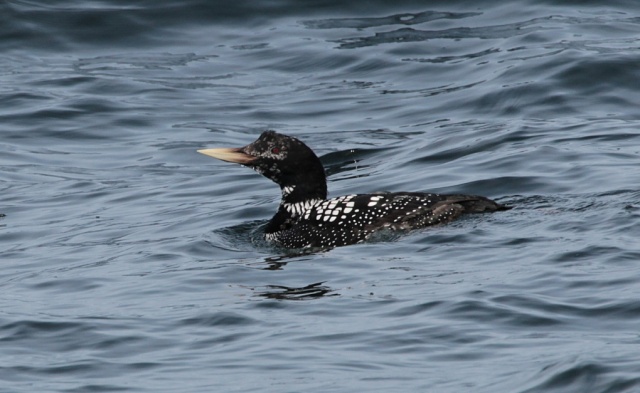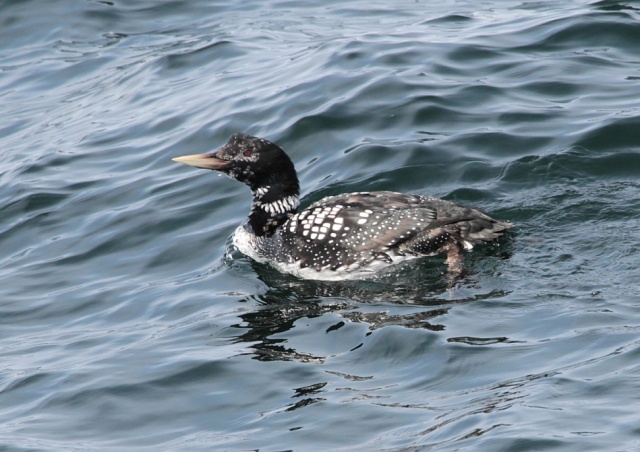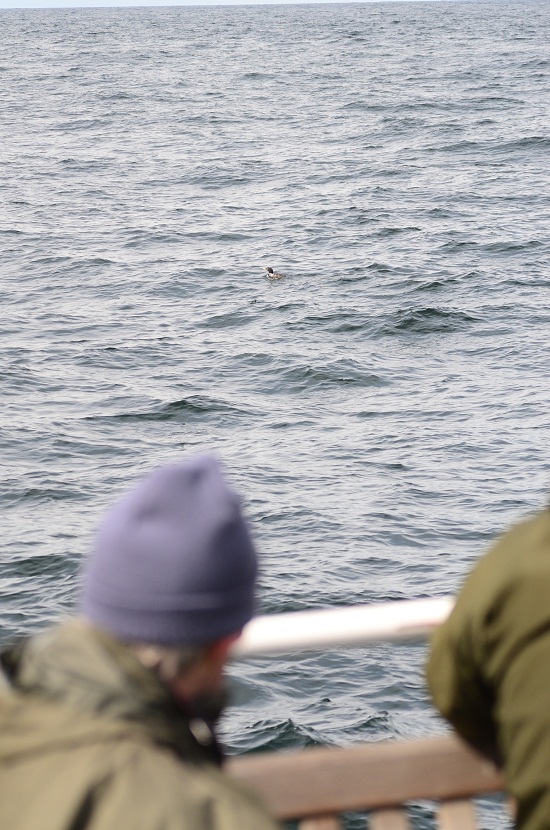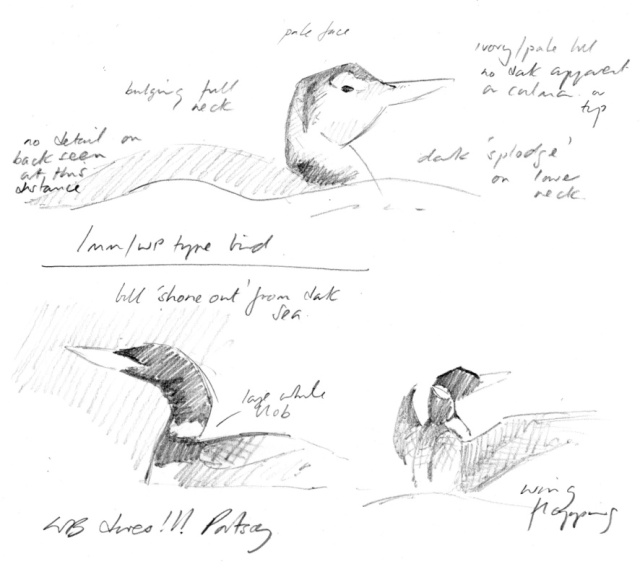White-billed Divers off Portsoy, North-east Scotland: discovering a new birding spectacle
Paul Baxter, Chris Gibbins and Hywel Maggs
In April 2011 Peter Osborn contacted HM to say that he has seen what he thought could have been a White-billed Diver off the harbour at Portsoy, North East Scotland. At this time White-billed Diver was a very rare bird in the region, with only a handful of records, so the sighting was well worth checking out. After work on Monday 25 April CG and HM drove up to Portsoy and arrived to find a flat-calm sea and perfect viewing conditions. Much to their amazement they counted 5 White-billed Divers in the bay, mostly in or approaching summer plumage. Wow! They were all rather distant, but unmistakable with their ivory ‘tusks’ shining out in the early evening sunshine. The distance meant that photographs were impossible, so HM and CG made some field notes and sketches (Plate 1) and alerted local birders to the spectacle unfolding on their doorstep.
Plate 1. Field sketches of Portsoy White-billed Divers on 25 April 2011. Chris Gibbins.
PAAB went up at the weekend, just four days later, but no birds were present. So, what was going on? Were the 5 birds a one-off event, or were White-billed Divers present off Portsoy each Spring? Or perhaps they were present all winter? The Spring passage of White-billed Divers on the Western Isles is of course rather well known, so the three of us agreed to start going up to Portsoy regularly to try to establish what the true situation was.
For the remainder of Spring 2011 and over the following two winters we made regular trips to Portsoy. We only had a single bird in the winter of 2011/12 (from 17th March until 17th April, a bird in active wing moult) and there was certainly no clear evidence of a Spring peak. In the 2012/13 winter the first bird was not seen until 18 March, when three winter-plumaged individuals were present.
From the time of the first sightings in 2011 we discussed the possibility of chartering a boat, so after the three birds on 18 March 2013 PAAB made contact with Gemini Charters at Buckie (a harbour just West of Portsoy) and made plans for some off-shore forays. Two trips were arranged initially (one on 14 April and another on 21 April), with a different group of birders on each one. All available places were taken on each trip, and each had an entirely different group of birders. The three of us were scheduled to be on the first trip but unfortunately this was cancelled due to bad weather. The second trip (i.e. on 21st) therefore became the first, but as it was already full there was no room for us; there was nothing we could do but reschedule our trip and wait to see what the others saw on 21st. They scored, with between 7 and 10 birds seen in the bay just off Portsoy harbour. It was gripping stuff – up to 10 White-billed Divers in one spot in North-East Scotland!
Our trip was rescheduled to 28th so we waited nervously for news of the weather. The weather for 28th was not looking good so the trip was changed to a narrow window in the early afternoon of 27th. As it turned out, this window could not have been better – we had 13 birds over the course of the 3 ½ hour trip. The majority were close to full summer plumage so it was a spectacular day, although the rolling sea made viewing and photography difficult. The photos were little better than record shots, but we managed complete a looped survey route and secure GPS coordinates for the birds
 Plate 2.One of the closer birds seen on 27th April. Most birds were in a similar plumage to this, close to but no quite in full summer dress. Chris Gibbins
Plate 2.One of the closer birds seen on 27th April. Most birds were in a similar plumage to this, close to but no quite in full summer dress. Chris Gibbins
 Plate3.The same bird as plate2. Chris Gibbins
Plate3.The same bird as plate2. Chris Gibbins
 Plate 4. Watching a White-billed Diver from the MV Gemini Explorer, April 2013. Paul Baxter
Plate 4. Watching a White-billed Diver from the MV Gemini Explorer, April 2013. Paul Baxter
 Plate 5. Watching a White-billed Diver from the MV Gemini Explorer, April 2013. Paul Baxter.
Plate 5. Watching a White-billed Diver from the MV Gemini Explorer, April 2013. Paul Baxter.
On both boat trips the birds were concentrated into a remarkably small area; all 13 on the trip of 27th were in the area between Logie Head (just east of Cullen) and Portsoy. We have checked the coastline a few miles either side of Portsoy on several occasions and not seen any birds, so it does seem that all the action is concentrated around Portsoy. The relatively small number of birds seen on our mid-winter visits suggests that it is primarily a Spring passage phenomenon, but for the moment we do not know what is so attractive about Portsoy Bay to these birds, nor how long into the Spring and early Summer they remain. Whether this is a new phenomenon or whether birds have been overlooked in the past also remains unclear. Prior to our regular visits to look for divers the area of coast around Portsoy was very underwatched, at least relative to the areas further west (towards Spey Bay) and east (around Banff and Fraserburgh) so divers may always have been there in Spring. Alternatively, their presence may be a recent phenomenon caused by changing environmental conditions elsewhere. We simply don’t know. However, what we know for sure is that ‘discovering’ that White-billed Divers occur in such numbers off our coastline has been a great experience.
Paul Baxter, Chris Gibbins and Hywel Maggs, Aberdeenshire







tried to see these last Friday but failed miserably – well done guys!!
Well done. What frustrate most is that all our birding books coverage areas for bids is outdated. For example, I birdied in zull em see in June 2012 saw a great northern diver, at klingnauer straussee a ruddy shelduck (60-70). My books show that it is about 1000km out of range. So newer not expect the unexpected. Greetings. Paul birdmad
Similar trips have beeen made in 2012 and 2013 in Denmark since an in area North West of the Island Anholt in Kattegat in 2009 was discovered as a winter/spring resting place for White-illed divers (WBD) by at team from the company Marine Observers a.
The first Danish trip trip was arranged by Henrik Haaning Nielsen at April 15th 2012 see: http://haaningsblog.blogspot.dk/2012/04/adamsii-experience-tour.html (Danish) and had 10 WBD.
Three trips was arranged in 2013. Two from Sæby in Northern Jutland on the 14th and 21st of April and one from Gilleleje, Northern sealand om the 28th. Only the trips on the 21st and 28th was made and only the one on the 21st was sucessfull in locating White-billed divers (5) and Great Northern Divers (8). The trip on the 28th had one GND and two unidentified large divers (this trip was “unsucessfull” probably due to longer distance to the area and bad weather).
As mentionned above both White-billed Divers and Great nortern was seen on the 21st of April. Interrestingly the two species was lumped in two different areas with two different sea dephts. All White-billed was found where the deapth of the sea is 12-13 meters where as the Great Northern was found at 8 meters of deapth.
For 2013 trips see below: (All links is in Dansih. If you use Google translate it will probably be both funny and interresting to read):
http://birdsdk.blogspot.dk/2013/04/the-great-kattegat-adamsii-tour-april.html (Description and pics from the 21st of April tour by Kent Olsen).
http://haaningsblog.blogspot.dk/2013/04/adamsii-touren-et-overblik.html (Google earth pic with the distribution of the divers (Islom = GND and Hvidnæbbet lom = WBD)
http://haaningsblog.blogspot.dk/2013/04/adamsii-tour-2013.html (Pics. and description of the 21st. of April tour by Henrik Haaning Nielsen the “inventor of theese tours in DK).
cheers
Lars Michael
Hi Lars Michael. Thanks a lot for this information; all very interesting. The view that seems to be emerging here too is that white-billed prefer deeper water. We also have a sense that coastlines with cliffs are better for them, but possibly this is an autocorrelation with water depth. We have many sand dune systems here in NE Scotland, and the sea off these can be very good for other species of diver, but all the white-billed i have seen here have been off our rockier coastlines. For example, Rattray head is fantastic for Great Northern Divers (several tens); but ive not seen a white-billed anywhere near this dune coasline, whereas at Portsoy which has very different geology and a cliff-coastline seems to have appreciably more White-billed than Great Northern (at least in spring). Of course there will always be the odd exception with single birds in harbours and so on, but there does seem to be a rather clear general pattern to the sorts of areas/habitat favoured by these species.